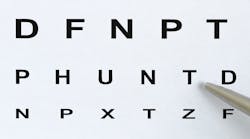The Equal Employment Opportunity Commission (EEOC) has issued an updated guidance for employers laying out the proper handling of visual impairments under the accommodations requirements of the Americans with Disabilities Act (ADA).
It is an updated version of its Visual Disabilities in the Workplace and the Americans with Disabilities Act technical assistance document. The document provides guidance to employers on when they may ask employees and applicants questions about a vision impairment, possible accommodations, safety concerns, and harassment prevention.
The revised guidance stresses that many individuals with vision impairments can perform their essential job functions, with or without reasonable accommodation, and warns that employers should not rely on stereotypes or incorrect assumptions, says attorney Fiona W. Ong of the Shawe Rosenthal law firm.
She makes the point that wearing ordinary glasses or contact lenses does not constitute a disability under the ADA. On the other hand, vision tests are considered to be medical examinations, and under the law employees can only be required to take such a test or meet an uncorrected vision standard when it is job-related and consistent with business necessity.
When it comes to dealing with job applicants, employers are not permitted to ask about vision impairments (including history, medications or current conditions) prior to making a job offer. They can ask whether the applicant can perform the essential functions of a job (which could include reading, working in low light, or inspecting small components, for example), with or without reasonable accommodation.
In addition, applicants do not need to disclose visual disabilities unless they are seeking reasonable accommodation for some part of the application process (for example, asking for application materials in larger font or in braille).
If an applicant has an obvious impairment or voluntarily discloses a visual impairment, and the employer reasonably believes they would need an accommodation to perform the job, the employer may ask whether one is required and of what type. “Employers must provide an accommodation during the application process, even if it believes that it will be unable to provide an on-the-job reasonable accommodation,” Ong stresses.
After making an offer, an employer may ask questions about the applicant’s health, including visual disabilities, as long as it is asking the same questions of all those doing the same type of job. Employers also may request additional medical information to follow up on particular responses, as appropriate—but can disqualify only those that are job-related and consistent with business necessity.
After Applicants Become Employees
Once applicants become employees, they can be asked questions about a visual disability only if the employer can show there is a reasonable belief that their ability to perform essential job functions is impaired or that they will pose a direct threat in the workplace.
“This can arise where employers observe performance issues that reasonably may be related to a known vision impairment, or where the employer observes symptoms that could indicate a vision impairment,” Ong warns. “Employers should keep in mind, however, that poor performance may be unrelated to a disability, and should not make assumptions.”
Employers may also ask about vision impairments if the employee seeks to participate in voluntary wellness programs, must comply with the terms of federal safety statutes or regulations, and wants use of sick leave related to a vision impairment when all employees are required to provide such information.
Where safety is a concern, an individualized assessment must be conducted to determine whether the person poses a direct threat in the workplace, to find out if they pose a significant risk of substantial harm that cannot be ended by reasonable accommodation. As part of this assessment, employees may be sent for medical examination.
Employers need not hire or retain anyone with a visual disability where it is prohibited by federal law, such as safety sensitive positions like truck driving.
Reasonable accommodations that can be used include assistive technology, such as text-to-speech software, optical character recognition technology, systems with audible/tactile/vibrating feedback, or website modifications, low-vision optical devices, digital apps or recorders, smartphone and tablet apps with built-in accessibility features.
Others are magnifiers or closed-circuit televisions systems, larger and high-contrast monitors, adjustable computer operating system settings, prescription safety goggles, anti-glare shields and filters, large-print or high contrast keyboards, wayfinding tools and tracking devices, talking products like calculators, color identification technology, and accessible maps and other materials (such as braille, large print or recordings).
Accommodations can include modification of workplace/employer policies or procedures (such as verbal introduction protocols, use of personal assistive items, and dress code modifications like sunglasses and filters.
Other accommodations include the use of guide dogs in the work area, work schedule modification to facilitate transportation, telework, leave, alteration of marginal functions, reassignment to a vacant position), ambient adjustments (such as brighter office lights, audible or tactile signs and warnings); sighted assistance or services (such as a qualified reader).
In addition, consider providing sighted assistance or services, such as screen-sharing technology, qualified readers, sighted guides and obtaining assistance, input from orientation/mobility/assistive technology professionals, braille labeler and labels.
Ong also observes that the EEOC, in keeping with federal agencies’ recent focus on artificial intelligence in the workplace, specifically notes that employers must provide accommodations in connection with the use of software that uses algorithms or AI as decision-making tools. Employers should take steps to ensure that these tools do not screen out or disadvantage those with disabilities.
“Employers should make clear that they will not tolerate harassment based on disability or any other protected basis,” Ong stresses. “They can do this through a written policy, staff meetings and training. They must also respond promptly and effectively to any reports of harassment.”

